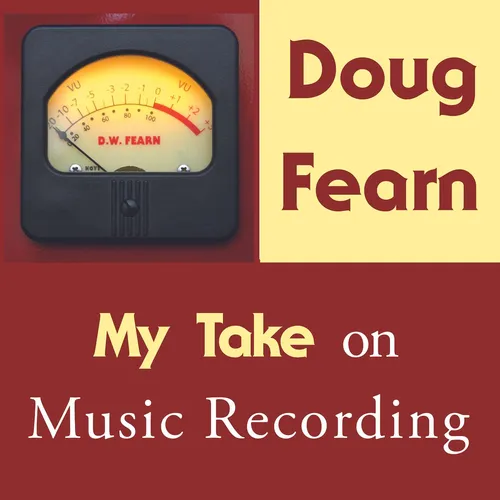
My Take on Music Recording with Doug Fearn
Doug Fearn draws on his 50+ years as a recording engineer, record producer, studio owner, and pro audio equipment designer to explain the art and science of recording for the audiophile, music lover, and people in the music recording industry.
- Update frequency
- every 19 days
- Average duration
- 38 minutes
- Episodes
- 108
- Years Active
- 2020 - 2025

Assistant Engineers
Recording sessions can be technologically complex. There are mics to set up, cables to run, headphones to deploy, maybe patching in the control room, and software and hardware to config…

Bleed Isn't Always a Bad Thing
Since the advent of multitrack recording, the goal of most engineers has been to keep the sound of every instrument totally isolated from all the others. That makes our job much easier,…

Spring Birds: How I recorded birds in the woods in DSD
I live and work in the woods, surrounded by wildlife. There are many species of birds and in the spring their songs are pretty amazing. Over the years, I have thought about recording th…

DSD Digital Recording
Virtually all digital recording uses a format called PCM. But there is another digital format that works in an entirely different way. It’s called DSD, for Direct Stream Digital, and yo…

Does Quality Matter?
Does audio quality really matter?
Our society in general has seen a major loss in quality of goods and services. Music recording has not escaped this trend.
In this short episode, I give …

Building a Studio
Most recording occurs in a studio, and the design of that facility has a major effect on the quality of the recordings made there.
In this episode, I discuss some of the things that I th…

Monitor Speakers and how to get the best sound out of them
Monitor speakers are a necessity for most of our recording. But I have always had a problem with the sound of speakers, and I explain why in this episode.
Speakers always exist in a spac…

Recording for Vinyl
Vinyl record sales have been increasing every year for a while now. Today, vinyl outsells CDs. Fans like vinyl for its unique sound, and the large format of the jacket.
Record pressing p…

How We Learn Audio Engineering
If you are working as a recording engineer, how did you learn your craft? A formal recording program? As an intern with an accomplished engineer? Or maybe you figured it out on your own…

Single-Mic Recording
Using a single microphone, or one stereo mic, to record a musical performance all at once without any overdubbing can result in a recording that is very compelling to the listener. When…

Choosing Microphones to Buy
When you are just starting out in recording music, you are likely to need microphones. And if you have been recording for a while, you may feel the need to add to you microphone collect…

Joseph Arnold - Violinist, Author
Joseph Arnold is a talented violinist that has played on a variety of projects I have produced. He is also an excellent writer, who just published his first book, titled, “Soul Force: H…

The Art of Producing - Part 3 - Mixing & Mastering
In this last of three episodes on the art of producing, I talk about my process for mixing. It is all part of the concept of a song from the beginning. Mixing is where everything comes …

The Art of Producing - Part 2 - Mic'ing
This is the second of three episodes on the Art of Producing. In this one, I talk about the mics and equipment I use in my studio, and the reasons why.
The example used for this series f…

The Art of Producing - Part 1
The art of producing a record requires knowledge of music, mastering the technical aspects of the recording process, and an ability to work with people.
This is the first of a three-part…

Fletcher, Munson, and You
Our perception of frequency balance varies with loudness, a fact documented by Harvey Fletcher and Wilden A. Munson, two scientists at Bell Laboratories. In 1933, they published a paper…

Getting the Best Vocal Recording
Almost all pop music features someone singing. Getting the best vocal performance is crucial, since most listeners respond to the words of a song and need to be able to hear them.
In thi…

Studio Accessories
There are many things that are important to create the proper studio environment for creative success. Most of these things are pretty mundane, but they do make a difference.
Examples I …

Shawn Dealey on Dolby Atmos
Ever since its announcement, I have been interested in learning more about Dolby Atmos. I was skeptical at first, primarily because of my experience with “Quad” back in the 1970s. That …

Compression
Compression and limiting are tools we use to modify the dynamic range of the music we record. In this episode, I present a brief history of where this technique came from, how it evolve…